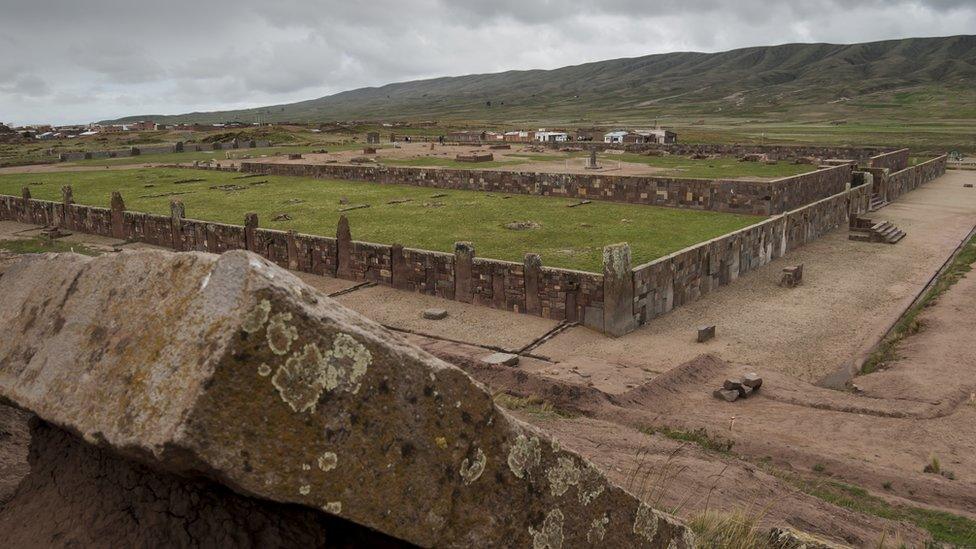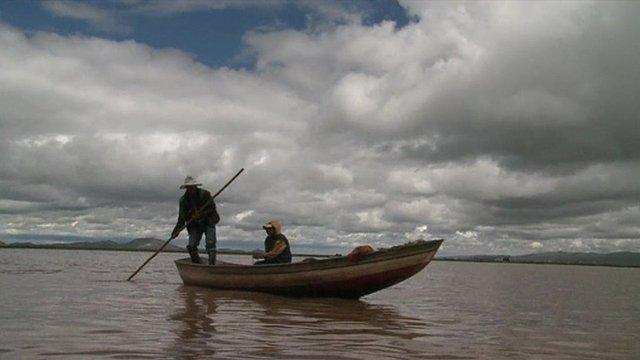Lake Titicaca: Underwater museum brings hope to shores
- Published

Specialised divers have located 10,000 items so far
Ever since Reddy Guaygua was a boy, he dreamt of discovering hidden ruins.
Born in Mapiri, 130km (80 miles) north of La Paz in Bolivia, he was the only person from his small town to study archaeology. "My goal was to work in the villages, visit their archaeological sites and work in them," he says.
Now, years later, his dream has become reality. Mr Guaygua is in charge of tourism and culture in the town of Tiquina.

Reddy Guaygua (left) has been fascinated by ancient sites since he was a boy
Tiquina lies on the shore of Lake Titicaca, which covers more than 8,500 sq km (3,300 sq miles) and creates a natural border between Peru and Bolivia. It was just five minutes from here that the submerged remains of an ancient civilisation was found 10 years ago.

You may also be interested in:

Following information provided by local people, archaeologist Christophe Delaere of the Free University of Belgium located 24 submerged archaeological sites in the lake's waters.

The most important site is in Santiago de Ojjelaya, and it is here that the Bolivian government is planning to build an underwater museum to preserve both the submerged archaeological structures and those on the shore.
The project, estimated to cost $10m (£7.8m) by the time it is completed in 2020, is being financed by the Bolivian government with help from Unesco, and has the backing of the Belgian development co-operation agency.
The 9,360-sq-m building will have two parts, one located on the shore where pieces salvaged from the lake will be exhibited and another semi-submerged part which will allow visitors to see some of the underwater structures, dubbed "hidden city", through glass walls.
José Luis Paz, director of heritage at Bolivia's ministry of culture, says that visitors will be able to see two types of underwater ruins: "ones which correspond to human settlements, sites that are hugging the lake's shoreline, and others [which were] the sites of spiritual offerings".

Experts believe some of the submerged structures were dwellings while others were spiritual sites
Mr Paz says the human settlements were probably flooded years before the spiritual sites, which were located in strategic places inside the lake.
A team of Belgian and Bolivian experts and specialised archaeological divers has managed to locate thousands of items.
"We found more than 10,000 pieces like vessels, gold pieces, ceramic, and thanks to the investigations it was possible to determinate that they belong to Tiwanaku culture and pre-Inca civilisations," Bolivia's Culture and Tourism Minister Wilma Alanoca says.
As they are well preserved, the plan is to only raise a few and leave most of them underwater.

Tiwanaku culture:
Pre-Hispanic empire that dominated a large area of the southern Andes and beyond
Reached its greatest power between 500AD and 900AD
Built exceptional ceremonial and public architecture from stone
Source: Unesco

Some of the pieces are estimated to be 2,000 years old and others date back to a time when the Tiwanaku empire was one of the most important Andean civilisations.

Remains of the Tiwanaku empire can also be found on shore

For Mr Guaygua and the people living in the 13 municipalities on the shores of the lake, the project to build the underwater museum offers the potential for increased tourism and thereby more work.
Currently most locals make a living from fishing or agriculture, and Minister Alanoca thinks that the museum could be key in stopping people from leaving their communities to go and work in the cities.
Unesco experts estimate that the ruins found so far only represent a tiny part of the Tiwanaku empire.
Mr Guaygua and fellow residents hope the treasure in the lake - and the sites they still hope to discover - may translate into more riches on the shore.
- Published19 March 2012
- Published5 January 2013
